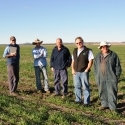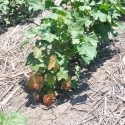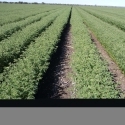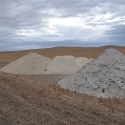13 Feb 2011
Dahlen Long Term Fertilizer Experiment
Results of canola grown on the long term N*P experiment at Dahlen, 10 km west of Horsham.
Dahlen trial site - Phosphorus response at long term site
Dahlen trial site history
In 1996 a long-term trial was established at Dahlen, about 10 km west of Horsham in the Wimmera. The trial, with direct drilling and stubble retention, follows the trends of crop production and soil nutrient levels with a combination of nitrogen and phosphorus rates.
The fertiliser rates were 0, 9, 18 or 36 kg P/ha, combined with 0, 20, 40, 80 and 160 kg N/ha.
Two nitrogen application strategies were used, either with all the nitrogen applied at sowing or split between sowing and the end of vegetative growth. The phosphorus source used was triple superphosphate and the nitrogen source was urea.
Since its establishment, crops planted included barley (1996, 2000, 2004, 2008) , chickpeas (1997), canola (1998, 2002, 2006), wheat (1999, 2003, 2007) and lentils (2001, 2005). Canola was chosen as the 2010 crop, following lentils in 2009 and barley in 2008.
With the good seasonal conditions, canola showed a strong response to phosphorus with the first 9 kg P/ha doubling yields and the next 18 kg P/ha plots raising yields to over 3 t/ha (see Figure 1). At the highest P rate (36 kg P/ha), establishment was poor probably due to fertiliser damage and so yields were somewhat lower.
Figure 1 – Response of canola to applied phosphorus at Dahlen, 2010
Response of canola to applied phosphorus at the Dahlen long term fertiliser trial in 2010. Source: Incitec Pivot Fertilisers, 2010.
The response to nitrogen showed a 17% yield increase to 40-80 kg N/ha (see Figure 2), with split nitrogen applications showing a small benefit over applying all the nitrogen upfront at sowing. The small nitrogen response is probably due to nitrogen fixation from the lentil crop in 2009 and possibly a carryover from the barley in 2008, which failed due to dry conditions.
Figure 2: Response of canola to applied nitrogen, Dahlen 2010
The canola crop’s response to nitrogen at the Dahlen trial site in 2010. Source: Incitec Pivot Fertilisers, 2010
When first established in 1996, the site had a Colwell P of around 22 mg/kg and a moderate to low site PBI. Since 1996, there have been 15 crops sown and 12 harvested, with crop failures in 2002 (wheat), 2006 (canola) and 2008 (barley).
At the end of the 2006 canola crop, a nutrient audit was undertaken at the site, with the inputs of phosphorus from fertiliser balanced against the phosphorus taken away in the grain. Figure 2 shows two trends from this study. Firstly, around 9 kg P/ha/year was in approximate phosphorus balance, with a slight surplus of 4 kg P/ha/year. This surplus appears as a rise in soil phosphorus test value from 22 to 33 mg/kg over the 15 years.
The results from this analysis indicates that over the relatively low yield decade of the 2000’s, the use of 9 kg P/ha approximately balanced the grain phosphorus removal and raised soil test levels to a desirable value from what was a low value.
Over that period, a phosphorus fertiliser strategy that matched input with output was a good approach, and in fact a separate economic analysis of this site reported some time ago showed that 9 kg P/ha also provided the best returns.
Figure 3: Colwell soil P value (blue line) and phosphorus balance (bars), 1996-2007.
Colwell soil P value (mg/kg) and apparent P balance (kg/ha/year) for the period 1996 to 2007 at the Dahlen long term fertiliser trial. Source: Incitec Pivot Fertilisers, 2010
Take home messages:
· The set fertiliser strategy for 9 kg P/ha and 20 kg N/ha continues to be a sound application rate, even in uncertain seasonal conditions.
· Failed crops or legume rotations can increase nitrogen levels in the soil, so soil testing is recommended to ensure nitrogen fertiliser is not over or under applied.
· Split nitrogen applications over the season may provide some yield benefits. However, the main advantage of topdressing nitrogen allows growers to assess seasonal outcomes before making any additional applications.




